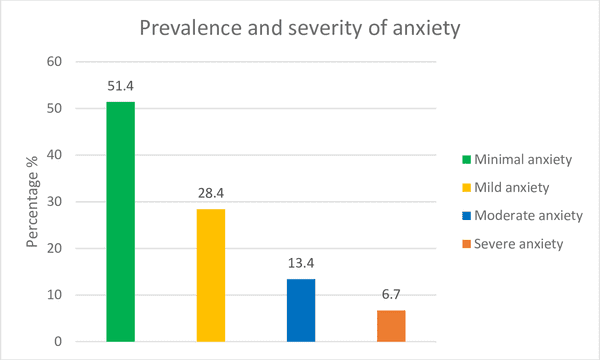Anxiety Assessment
3 Min Free Anxiety Assessment
Who Can Benefit From This Anxiety Assessment?
The Anxiety Assessment can benefit anyone who is experiencing difficulties with anxiety or suspects they may have an anxiety disorder. Anxiety is a common mental health condition characterized by persistent and excessive worry, fear, or nervousness that can impact an individual’s daily life, relationships, and functioning.
This assessment may be particularly useful for individuals who have persistent, unwanted thoughts or impulses, experience excessive worry or fear, or have difficulty controlling their thoughts or behaviors. The assessment can help individuals better understand their symptoms and determine whether they may benefit from seeking support from a mental health professional.

Anxiety Assessment Accuracy

The accuracy of an Anxiety Assessment can depend on several factors, including the quality of the assessment tool, the honesty and accuracy of the responses provided by the user, and the individual’s current state of mental health. It’s essential to note that an Anxiety Assessment is not a substitute for a formal diagnosis by a licensed mental health professional and it is best used as a screening tool to identify potential symptoms and risk factors for anxiety.
However, many Anxiety Assessments have been designed and validated by mental health professionals and researchers to ensure their accuracy and reliability. These assessments typically involve a set of standardized questions and scoring procedures to provide an objective measure of anxiety symptoms. It’s essential to remember that while a test can provide useful information, it should not be used in isolation to diagnose or treat anxiety.
Types of Anxiety Assessment
Generalized Anxiety Disorder 7-item (GAD-7) Scale
This is a self-report questionnaire that assesses the severity of anxiety symptoms. The GAD-7 consists of seven items and is commonly used in research and clinical settings.
Beck Anxiety Inventory (BAI):
This is a self-report questionnaire that assesses the severity of anxiety symptoms. The BAI consists of 21 items and is commonly used in research and clinical settings.
State-Trait Anxiety Inventory (STAI):
This is a self-report questionnaire that assesses both temporary (state) and long-term (trait) anxiety levels. The STAI consists of two separate scales and is commonly used in research and clinical settings.
Social Phobia Inventory (SPIN):
This is a self-report questionnaire that assesses the severity of social anxiety symptoms. The SPIN consists of 17 items and is commonly used in research and clinical settings.
Panic Disorder Severity Scale (PDSS):
This is a self-report questionnaire that assesses the severity of panic disorder symptoms. The PDSS consists of seven items and is commonly used in research and clinical settings.
Child Behavior Checklist (CBCL):
This is a questionnaire that assesses anxiety symptoms in children and adolescents. The CBCL consists of various items and is commonly used in research and clinical settings.
Treating Anxiety
Anxiety can be treated effectively with a combination of psychotherapy, medication, and self-care strategies. Here are some examples of treatment options:
- Cognitive Behavioral Therapy (CBT): This is a type of talk therapy that focuses on changing negative thought patterns and behaviors that contribute to anxiety. CBT may involve exposure therapy, where individuals gradually face feared situations to desensitize them to triggers.
- Medications: Anti-anxiety medications and antidepressants may be prescribed to treat symptoms of anxiety, such as excessive worry or fear. It’s important to only take medications under the guidance of a medical professional.
- Relaxation Techniques: Engaging in relaxation techniques, such as deep breathing, meditation, and progressive muscle relaxation, can help individuals manage symptoms of anxiety and reduce stress levels.
- Lifestyle Changes: Making lifestyle changes, such as reducing caffeine intake, regular exercise, and improving sleep habits, can help individuals manage symptoms of anxiety and improve overall well-being.
- Support Groups: Joining a support group can provide individuals with social support and a sense of community, which can help reduce feelings of isolation and improve mood.

